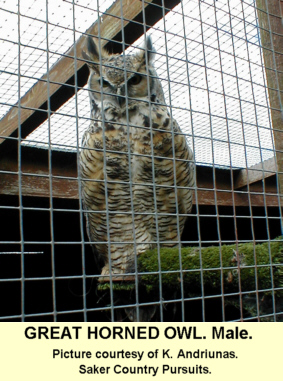
Bubo virginianus virginianus
GREAT HORNED OWL.
Bubo virginianus virginianus
IDENTIFICATION. The largest owl to be found in the Americas the Great Horned Owl is divided into seventeen sub-species that range from Alaska to South America.
As the name suggests the Great Horned Owl derives its name from the horn like ear tufts on its head. Like the European Eagle Owl these tufts have nothing to do with hearing and are used more for display and camouflage. Plumage colouration can be variable ranging from light greys to black and white or even a reddish tinge. The underside has dark barring on light grey with white feathers on the upper breast. The eyes are large and more yellow than the European Eagle Owl. The feet are feathered to the toes.
The scientific name 'virginianus' originates from the American state of Virginia which in turn was named after Elizabeth I 'The Virgin Queen'.
Occasionally mistaken for the American Barred Owl, Strix varia.
IN FLIGHT. The flight is similar to that of the European Eagle Owl. Slow wing beats and gliding close to the ground are its normal pattern, but fast bursts of speed are used in pursuit of nimble prey.
DISTRIBUTION. Bubo virginianus virginianus is found in Central and Eastern North America and Southern Canada. A bird that is happy in both city parks and open farmland, dense woodland and open rocky canons. Sub-species can be found in Alaska, Mexico, Panama, Columbia, Brazil and Venezuela.
FOOD. Generally mammals to the size of hares, including monkeys in its southern range. Birds such as grouse, pigeons and corvids. Larger avian prey can include turkeys, heron and swans. Insects of varying descriptions also supplement the diet. Other bodies found in Great Horned Owl nests include cats, dogs and young Alligators!
BREEDING. January-March. 2 to 4 eggs laid in a simple scrape on a rocky ledge or on the ground under cover and abandoned tree nests. Great Horned Owls have been known to kill Red-tailed Buzzards when evicting them from their nests! The young hatch after 30 days, being incubated by both the sexes. The young fledge at around 10 weeks old.
SIZE. 45-63cm (18- 25in)
WEIGHT. 900g-1800g (2lb-4lb)
WINGSPAN. 91-152cm (36-60in)
CALL. Whoo-Whoowhoo-Whoo. A defensive Whaaark. Occasionally a cat like Meeow.
FALCONRY.
The Great Horned Owl has the reputation of being the owl to fly if you wish to hunt. Though smaller than the European Eagle Owl the tenacious attitude of this American Bubo increases your chances of taking quarry. As the list of prey items above suggests this owl is quite capable of taking most prey presented to it. However like all owls their attention span is poor. When you have spotted a rabbit sat in the middle of a field your owl is looking at a blade of grass at your feet, but nothing worthwhile is ever easy. If you can get your owl to catch prey regularly then you have achieved something to be proud of.
When it comes to training Eagle Owls (in fact most owls) the chicks are taken from the nest about three weeks after hatching for imprinting. This basically means you become mum and junior starts to think of himself as human. So from the day you pick up your bird until it is flying you will be chopping dead chicks, rats and mice for tea, cleaning up the unending pools of owls droppings (watch out for the brown ones!), finding out that owls have no attention span and generally devoting more time to him than to the TV!
Like most large owl the problem with Great Horned Owl's can be their loud hoot. Age must also be taken into consideration. The lifespan can exceed 35 years. It is always best to be aware that however much you trust your owl, it is still an animal and could therefore be unpredictable if poorly treated, coming into the breeding season or if it is just having a bad day.
Falconry marks
![]()
![]()
![]()
![]()